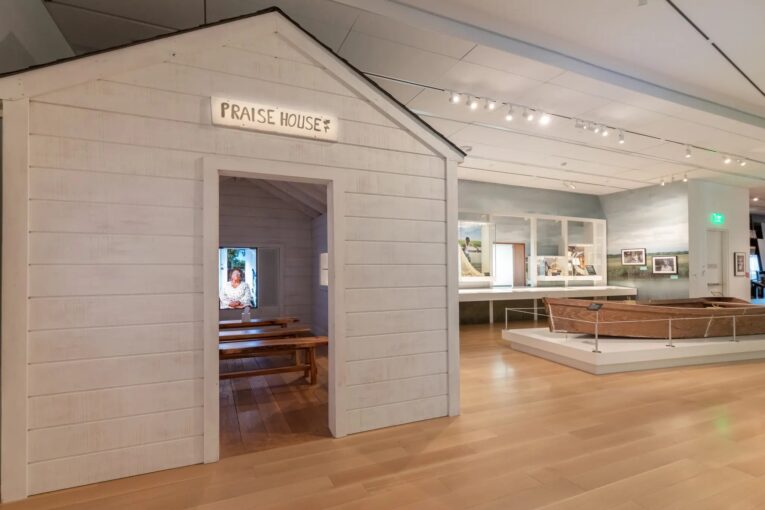A new museum brings to life African History in America

[Charleston, SC—The African] BY SOUMANOU SALIFOU
Few places in America brings to life as powerfully as does the just-opened International African American Museum (IAAM) in Charleston, South Carolina the indelible connection between Mother Africa and her children who gave America legendary figures like Harriet Tubman, Frederick Douglass, Marcus Garvey, W.E.B. Dubois, George Washington Carver, Lewis Armstrong, and millions of others who helped build from the ground up the most powerful nation on earth.
A landmark in world history
The 45,000-square-foot facility stands on one of the major historic landmarks in America, Charleston’s historic Gadsden’s Wharf that served as a slave trading port. Gadsden’s Wharf was the largest slave trading port in the country and the first destination for an estimated 100,000 enslaved men, women, and children during the peak of the notorious trade. According to historians, an estimated 40% of enslaved Africans landed at Gadsden’s Wharf which is now home to South Carolina Aquarium and the IAAM.
The historical jewel comprises over 700 artifacts dating from the 17th century to contemporary objects, alongside 1000 image and media collection pieces. That is not to mention the Center for Family History, a world-class genealogy and ancestry resource center known for having hosted genealogy classes and workshops since 2020, connecting African Americans to their African roots and their history in the United States.
The uphill march
Like most beautiful stories, the crafting of the jewel that is the International African American Museum goes back several decades. Local Charleston TV channel News 2 recounts how the initiator of the museum, longtime (white) mayor of the city, Joseph P. Riley Jr., shares with the station his vision and determination to build the museum. Riley famously said that every day he placed a note in the breast pocket of his suit jacket that says, “Build the museum!” The recount, obtained by the reporter from an official close to the mayor, goes: “Mayor Riley said of all the buildings, bridges, and ballparks built during his 40-year career serving the city of Charleston, constructing a museum that would tell the story of the transatlantic slave trade was most important to him.”
Riley, the city’s longest-serving mayor, was inspired in 1998 to build the AAIM after reading the book “Slaves in the Family” by Edward Ball in which the mayor reportedly saw for the first time the harshness and the brutality endured by African men, women, and children brought to these shores against their will. Riley felt no other place could tell the story better than this landmark in Charleston.
But it will take a two-decade bumpy journey for the idea that crystallized in the mind of the mayor to climax into the groundbreaking of the historical landmark on October 25, 2019. The choice of June 27, today, as the official opening day, is designed to coincide with the third official celebration of Juneteenth, the latest federal holiday in the United States signed into law in 2021 by President Joe Biden to commemorate the end of slavery.
Click here to read more: African American Museum to open in South Carolina in June
Not all the 23 years that it took the International African American Museum to come to life were due to the usual logistical challenges. Talking to reporters, the museum’s president and CEO, Dr. Tonya Matthews, said: “Some of those delays were our commitment to getting this absolutely right and I hope that when folks walk into the museum they won’t say ‘Wow, I can’t believe it took so long.’ They will say ‘Oh my, how did they get it done so quickly?’” Interactive technology in every gallery, on every wall, and on every table are some of the amazing features in a place full of history where artifacts and exhibits bring the visitor face-to-face with one of the most important pages of human history.
A poignant story told in gallery after gallery
- The Transatlantic Experience gallery: in this space that visitors first see when they enter the IAAM, eight digital screens tell the stories of ancient and modern-time African civilizations.
- The Gullah Geechee gallery: a representation of African Americans who live in the Lowcountry region of South Carolina and Georgia, who are known for preserving more of their African linguistic and cultural heritage than any other African American community in the United States.
- The African Roots and Routes gallery: this highlights modern African diasporic connections.
- The Port of Departure gallery: contains the names, obtained from recorded court cases, of the men, women and children who were enslaved.
- The Port of Arrival gallery: this gallery, like the Port of Departure gallery, contains the names of slaves from the IAAM’s own records, local and Lowcountry plantations.
- The Atlantic World gallery: standing between the Port of Departure gallery and the Port of Arrival gallery, the Atlantic World gallery is a cross section of different communities of the African diaspora from all over the world to show the connection between them. This gallery, with a look out to the Atlantic Ocean, underscores the significance of Charleston, with its port and Gadsden’s Wharf, in the slave trade.
- The Carolina Gold gallery: this gallery shows how, through rice cultivation, using both their hands and their knowledge, the slaves brought innovations that turned rice into a cash crop, making Charleston the richest city in all the colonies—obviously thereby enriching the colonists.

The International African American Museum boasts several other galleries that are a must-see, not only for the African American community, especially for the young generations who know so little—if anything—about their history, as well as other segments of the larger community.

